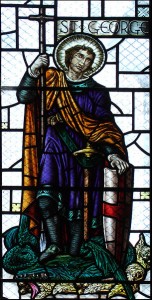 Happy St George’s Day to my fellow English men, women and children, and anyone who has English blood. I’m half Welsh so I celebrate St David’s Day and St George’s Day, just need to find a bit of Irish and Scottish blood in my ancestry and then I can find an excuse for those feast days too!
Happy St George’s Day to my fellow English men, women and children, and anyone who has English blood. I’m half Welsh so I celebrate St David’s Day and St George’s Day, just need to find a bit of Irish and Scottish blood in my ancestry and then I can find an excuse for those feast days too!
Wondering who St George is and why England has him as its patron saint? Here are some St George facts (well,also myth and legend I’m afraid):
- He was born in the 3rd century AD in Cappadocia
- He was from a Christian family
- He was a Roman soldier
- He protested against the persecution of Christians
- He was imprisoned and tortured for his faith
- He was beheaded in Nicomedia, Turkey, on 23rd April 303 AD by the Emperor Diocletian
- The Emperor’s wife converted to Christianity because of St George’s courage and faith. This led to her being executed too.
- English crusaders brought back to England tales of St George and churches were dedicated to him.
- In the 14th century, English soldiers wore a sign of St George because he was seen as a protector of Christian soldiers.
- The Order of the Garter, the famous chivalric order, was founded by Edward III in 1348 and the order was put under Saint George’s patronage. Knights were elected on 23rd April, St George’s Day.
- The chapel of the Order is St George’s Chapel, Windsor Castle, which was constructed by Edward IV and Henry VII.
- St George became the patron saint of England in 1415 after the English victory at the Battle of Agincourt. It was said that English soldiers saw St George fighting with them at the battle.
- The legend of St George slaying a dragon and saving Princess Cleolinda dates back over 1000 years.
- StGeorgesDay.com is campaigning for St George’s Day to be made a public holiday in England.
Thanks to StGeorgesDay.com for the above facts.